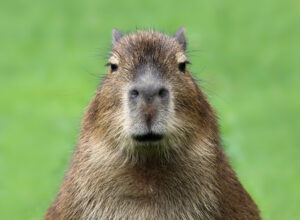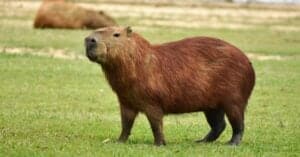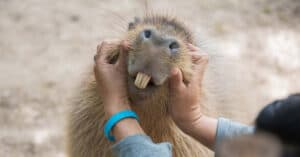Even though technically they are rodents, it’s almost impossible to not love capybaras. In fact, capybaras are the largest rodent in the world (and can weigh up to 150 pounds!), and yet people from all over the globe seem to be falling in love with these semiaquatic cuddle bugs. But what is it that draws so many people — and even animals — to capybaras? Do they really get along with everyone? Let’s take a closer look!

Even though
technicallythey are
rodents,it’s almost impossible to not love capybaras.
©Horus2017/Shutterstock.com
Capyabara Social Life
Although they are kind and compassionate creatures, capybaras are not as outgoing as you might imagine. In fact, they can be quite shy, preferring to stick together in their large herds. Although they may be unassuming, capybaras are extremely social animals who love to talk to each other throughout the day. If you are ever lucky enough to witness a herd of capybaras, you are likely to enjoy the sweet symphony of their unending chatter, with adorable squeaks, chirps, and barks.
Capybaras typically live in herds with 10 to 20 individuals. However, larger groups are not entirely uncommon, with some even numbering up to 100 at times! Groups of capybaras spend their days basking along the edge of rivers and ponds, where they enjoy bouts of synchronized swimming together in the water. Capybaras spend half their lives in the water; they can hold their breath for up to five minutes at a time, and they even mate exclusively in the water.
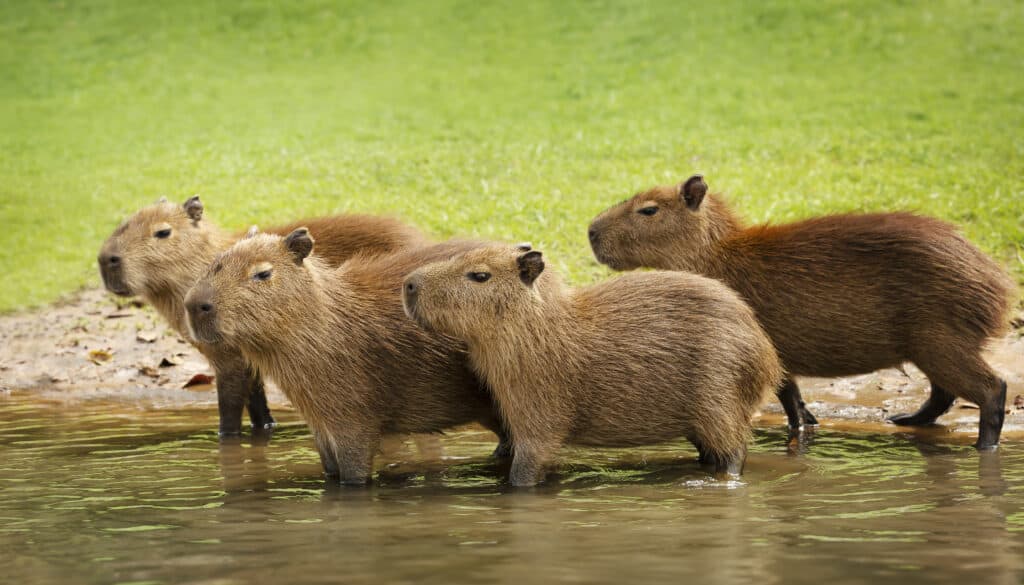
Capybaras live together in large groups of 10-20 members, although larger groups may have 40 individuals or more.
©Giedriius/Shutterstock.com
Cuddling with Capybaras
Since they spend so much time around water, it makes sense that capybaras would come into contact with a wide variety of other animals who stop in for a drink. Capybaras are gentle and peaceful river residents who enjoy napping along the water’s edge — and often do so with other animal species as well. You can find pictures all over the internet of these adorable animals snuggled up beside turtles, birds, ducks, rats, and even monkeys as they enjoy a little capy-nap by the water. Since they are so chill, they have no issue sharing their space with other animals, and even getting in a little snuggle time occasionally with smaller ducks nestled on their backs.
Capybaras are also known to be excellent and friendly taxis in the animal world. Birds and monkeys commonly hop on the back of a capybara for a ride as this giant herbivore searches for grasses, bark, plants, and aquatic vegetation to eat. Sometimes capybaras even serve as cruise guides for other animals, letting them sit atop their heads as they swim through the water!
However, if you see a capybara lying on its side with a yellow-headed caracara perched atop it, don’t panic just yet. Most likely the capybara is enjoying a nice spa day, courtesy of its feathered friend! Birds often make friends with capybaras and act as a natural cleaning service, picking off ticks and other pesky bugs that hitch a ride in the capybara’s fur. It’s a symbiotic relationship, since the yellow-headed caracara also gets to enjoy eating a bunch of tasty bugs.

Capybaras are very social animals, both within their own species and with other animals. Yellow-headed caracaras often help remove ticks from capybaras, in exchange for a free ride.
©iStock.com/slowmotiongli
Do Capybaras Really Get Along With Everyone?
So, do capybaras really get along with everyone? In general, the answer is yes! Believe it or not, capybaras have even been observed chilling with crocodiles and alligators! It might sound crazy, but it’s true. You see, capybaras really don’t pose any threat to anyone around them, so most animals just leave them be. Capybaras have made friends with anything from cats and dogs to birds and monkeys!
In addition, capybaras are quite caring creatures, who often “adopt” orphaned animals of other species. At Rocky Ridge Refuge in Arkansas, a rather famous capybara named Cheesecake is a beloved foster mom of all kinds of animals — puppies, kittens, ducklings, deer, tortoises, emus, older dogs, chickens, and even a miniature horse!
However, these cute and cuddly critters are not without predators. Capybaras are commonly on the menu for carnivores like caimans, anacondas, jaguars, and even humans! That’s right, in some South American countries, capybara meat is a popular (albeit controversial) dish.
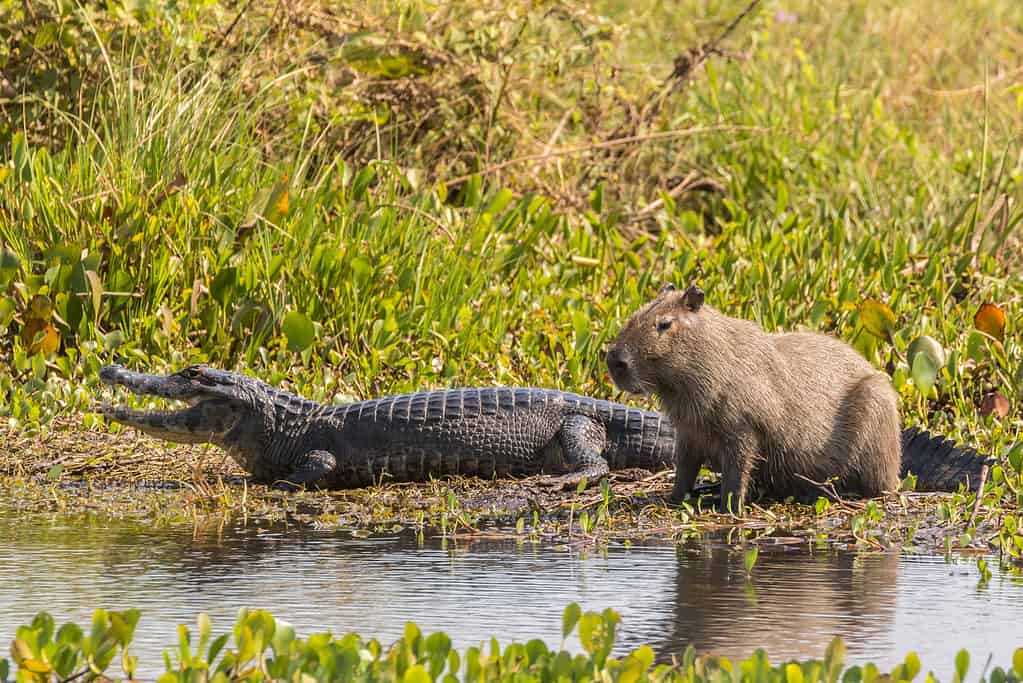
Capybaras really don’t pose any threat to anyone around them, so most animals just leave them be.
©Danita Delimont/Shutterstock.com
Capybaras as Pets
Well, if capybaras are as friendly and amiable as they sound, do they make good pets? The answer to this question is a bit complicated. Some people do keep capybaras as pets. However, capybaras are rather high-maintenance pets with many unique and special needs.
Capybaras are herd animals, so they do not like being alone. In fact, leaving a capybara alone is not only uncomfortable for the animal, but it can be devastating to their physical health, as well as their emotional and mental well-being. So, if you are going to get a capybara, you better make sure that you get at least two.
In addition, these social herd animals are grazers and need lots of space to roam around. A pet capybara will need a safe, outdoor enclosure with plenty of grass and quality food to graze on. In addition, they are semi-aquatic and require a pool or body of water to swim in — although this may seem inconvenient, it is non-negotiable.
While a pet capybara is a lot of work, it can also be a fulfilling experience for the right animal guardian. Capybaras are sweet and gentle creatures and can form strong bonds and attachments with their owners and other animals around them.
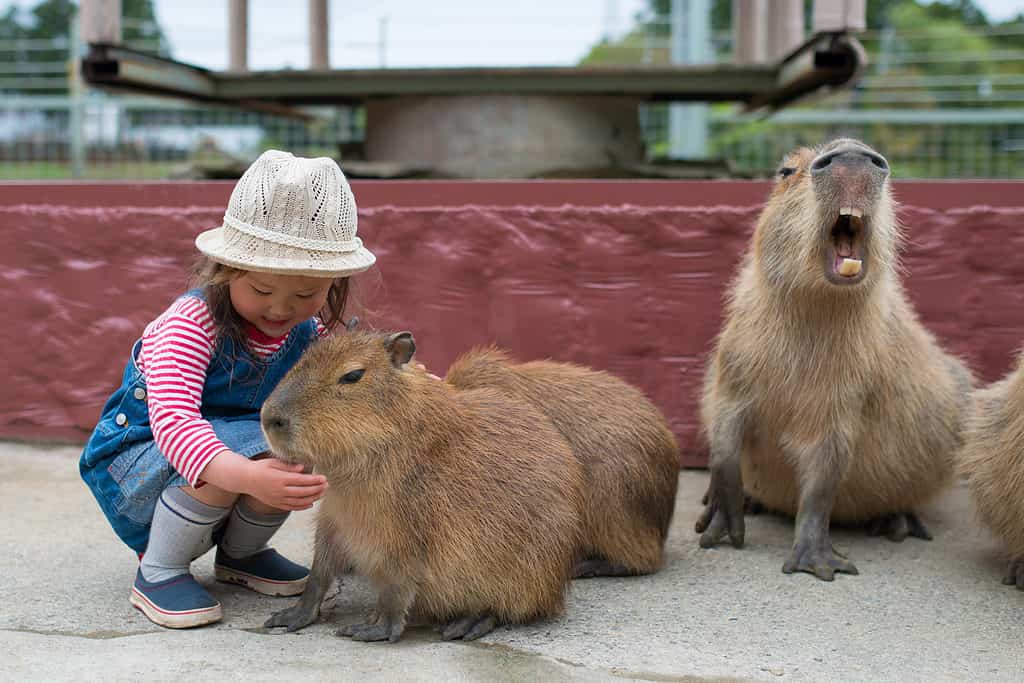
Capybaras are sweet and gentle creatures and can form strong bonds and attachments with their owners and other animals around them.
©Purino/Shutterstock.com
Bonus: How Much Do Capybaras Cost?

Capybaras are gentle creatures that get along with other pets.
©CoralCapy/Shutterstock.com
After reading this article you may be so enchanted with the gentle capybara that you may want to adopt one as a pet. Or, rather, adopt two, because they require the company of another capybara. Perhaps you have a large, fenced-in yard with a pond – just waiting for a pair of capybaras to enjoy! So, how much do capybaras cost? There are several variables to consider that are influenced by the animal’s age, health, genetic traits, breeding capabilities and the location of the source or breeder. Baby capybaras are more expensive than older animals but have more potential for adaptability. Captive-bred capybaras are generally more expensive than those caught in the wild. The cost of a capybara could range anywhere from $1,500 to $5,000 or more. For more information, visit Capybara Prices in 2023: Purchase Cost, Supplies, Food, and More!
The photo featured at the top of this post is © Henner Damke/Shutterstock.com
FAQs (Frequently Asked Questions)
Are capybaras friendly with humans?
Initially, capybaras can be shy around humans, but they warm up quickly. Many capybaras are known for developing deep bonds with the humans that care for them. They even like giving their human companions kissing, hugs, and lots of cuddles!
Are capybaras friendly with other animals?
Capybaras are naturally friendly and easy-going with other animals. They can be shy, especially if the other animals are larger than they are.
Why do other animals like capybaras?
Since capybaras live in herds with 10 to 20 individuals, smaller animals may like spending time with them for safety. In addition, capybaras are herbivores, so they are harmless to other animals around them. These easy-going semi-aquatic mammals are social, friendly, and gentle, and get along with just about everyone, so it makes sense that other animals would enjoy their company.
Are capybaras dangerous?
In general, capybaras are completely harmless. These giant rodents are gentle and calm and get along with just about everyone they meet. However, if they are provoked, a capybara can bite.
Capybaras are non-aggressive animals with easy-going personalities. It is extremely rare for them to bite. However, it can happen, especially if the capybara is provoked, if it is a male and it is mating season, or if it is a mother capybara protecting her babies.
These animals are rodents and have very large incisors and incredibly strong jaw muscles, so their bites pack a punch! So it’s best to treat capybaras with respect and give them their space. Even as a pet, you should never underestimate the strength of a capybara, or its sharp teeth!
Are there capybaras in the United States?
Capybaras are native to South America. However, there is a small population of these animals that was recently discovered living in north-central Florida.
No one is entirely sure how this small group of capybaras came to live in Florida, although there are a few theories. They may have once been pets but were then released (illegally) by their previous owners, or they might have escaped. Many argue that they come from a conservancy in Florida and escaped sometime in the 1990s. Within just a few years they bred and their population grew.
Thank you for reading! Have some feedback for us? Contact the AZ Animals editorial team.



